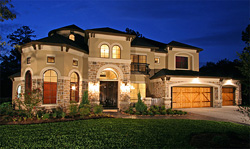Keys for Taking Beautiful Real Estate Photographs
Posted by Hojin on August 25, 2007
 I look through property photos on a daily basis and I’ve got to say that the real estate industry has done very little to educate people marketing properties on what a good photo looks like. After all, with the internet being such an integral part of real estate marketing, the internet photo of a home is in many case the only exposure that it gets with home buyers. Our photographs will never look like the ones in Architectural Digest because normal people do not have the time or money for lighting equipment but we can get a lot closer to getting that beautiful look like this photo taken by Matt Stec (http://www.mattstec.com). Just stunning. So I used the Photography for Real Estate’s 10 Essentials list as a basis for putting together a list every real estate photographer should keep in mind.
I look through property photos on a daily basis and I’ve got to say that the real estate industry has done very little to educate people marketing properties on what a good photo looks like. After all, with the internet being such an integral part of real estate marketing, the internet photo of a home is in many case the only exposure that it gets with home buyers. Our photographs will never look like the ones in Architectural Digest because normal people do not have the time or money for lighting equipment but we can get a lot closer to getting that beautiful look like this photo taken by Matt Stec (http://www.mattstec.com). Just stunning. So I used the Photography for Real Estate’s 10 Essentials list as a basis for putting together a list every real estate photographer should keep in mind.
The exterior photo is the most important. Since the exterior photo is the first and many times the only photo that buyers see on most websites and print publications, it is the most important. You need to keep the sun behind you when you take day time photos of a home, so photos of an eastern facing home will be best at sunrise and western
- facing homes at sunset when you get a warm golden glow from the sun. Northern facing homes are the most difficult to photograph and will require some advanced techniques. Homes with a southern front exposure just have the best lighting and will yield the best photographs. Probably the best lighting you’ll find is pointing the camera north or with the sun positioned behind you and off the left shoulder near sunset. Facing north this time of the day produces the most beautiful lighting for taking photographs. After all, photography is all about capturing light. Also a day with soft puffy white clouds in the sky provide the nicest background. Try to avoid harsh shadows across the facade when taking day shots. Polarizing filters are a help to photos taken in the middle of the day only when the sun is directly above you. The most striking exterior photos are taken during the “magic hour” which is the 10-15 minutes prior to sunset when the sky turn a deep violet like these photos on this post.
Avoid overly bright windows in your interior photographs. The only way to avoid this is take interior photos only during the “magic hour” or at the beginning hour of sunrise when the level of light on the inside resembles the light on the outside of the windows. You can also just compose the photo to exclude the windows during other times of the day. Sometimes you can get away with shooting interiors with windows in the middle of the afternoon if it a dark cloudy day outside. A set of powerful strobes will allow you to avoid bright windows during the day but they are hard to set up and move around. You can also take two or multiple exposures and combine them in Photoshop.  AECbyetes has a really simple tutorial on this technique. You can also take multiple photos with different exposure to create a HDR image. The post processing time for this technique is long and tedious but the results can be absolutely stunning. At the same time, HDR images all have an unrealistic quality to them, but I personally enjoy the unrealistic quality whereas others just hate it. Popphoto.com has a wonderful tutorial on creating HDR images HERE.
AECbyetes has a really simple tutorial on this technique. You can also take multiple photos with different exposure to create a HDR image. The post processing time for this technique is long and tedious but the results can be absolutely stunning. At the same time, HDR images all have an unrealistic quality to them, but I personally enjoy the unrealistic quality whereas others just hate it. Popphoto.com has a wonderful tutorial on creating HDR images HERE.
You need to keep in mind the purpose of the photograph. You need to ask yourself what features of the home are you trying to highlight? Photographs for purposes of marketing a home for sale will want to provide a wide perspective of the subject. Keep in mind you’re not selling the furniture, you’re selling the space.
Interior photos should be light and bright but keep in mind that most digital cameras tend to overexpose so you may want to take the exposure down a stop or 2. Pay careful attention to the light fixtures and make sure they are not blown out. The highlight blinkies on your camera will help you avoid overexposed lights in your photos. On camera flashes are just not good at all and you really need an external flash bounced off a wall or ceiling to get decent lighting. External flashes work best when hand held away from the camera so Nikon’s remote trigger feature comes in handy with this situation. The ideal set up is a set of 3 Novatron strobes with umbrellas but can be tough to move around and set up but they are reasonably priced. A constant light set up with umbrellas is the best set up but you’ll need lots of experience and expensive equipment to pull it off so I dare say leave this type of set up for the pros at Architectural Digest.
The composition should be simple. Remove all the clutter off your refrigerator door, coffee table, etc. because they will distract the attention away from the room. Having an object in the foreground will help provide some perspective in a 2 dimensional medium.
Use a wide angle lens. Unfortunately wide angle lenses require an SLR camera and is really an expensive but necessary requirement for getting descent real estate photos. You’ll also need a tripod and external flash. Using the flash properly is a whole other issue altogether but you can get the basics from the Strobist Blog. The “slow sync” feature on your camera is an invaluable setting to get natural looking lighting for interiors especially with just one external flash. Here are some suggestions for equipment: (on a budget $500-wide) Nikon D40 w/18-55mm kit lens, ($1,500-$2,500 mid priced-wider) Nikon D200 w/12-24mm lens or Canon 30d w/10-20mm lens, (no budget $5,000-$7,000-full frame/widest) Nikon D3 w/14-24mm lens or Canon 5D w/14mm lens. Man I wish I didn’t have a budget.
Keep vertical walls vertical. Always hold the camera parallel to the ground to accomplish this. This sounds like an easy task but I rarely pull this off without using a level on the camera. This simple little tool will significantly shorten post processing time.
Keep straight lines straight. Since lenses are curved, the edges of photographs tend to curve. An easy way to avoid this is to just take a photo of a wider perspective than you want and then crop the edges off until you have only straight lines or you can edit the photo using software such as Adobe Photoshop Elements or Photoshop CS3. The 14mm lenses from Canon and Nikon are renowned for virtually no lens distortion but costs around $2,000. Pay special attention to the door frames as they are often difficult to get straight. I’ve found that shooting things straight on and not at an angle helps with getting the door frames straight. At the very least, use the straightening tool please. I’m so tired of looking at crooked photos on the MLS.
Experiment with white balance. Since there are so many different light sources in homes, the camera has a hard time figuring out which white balance to use. The Nikons are better for adjusting white balance because each setting can be adjusted up or down while Canons lack this ability. Incandescent light will appear yellowish, florescent lights will appear greenish, and tungsten/halogen lights will appear blueish. Digital cameras measure light based on variations of gray, so a great way to get the proper white balance is to use a gray card and use the exposure taken off the card. An Expodisc does even a better job at white balance but it costs about a hundred bucks. I’ve found that my white socks or a white piece of paper works almost as good. For exterior shots in full afternoon sun, the daylight setting turned all the way down on the Nikons and the shade setting on the Canons are a easy way to fake the warm golden colors you get near sunset.
You also need to size, crop, and sharpen all digital photos. Depending on which website or publication your home will appear in, you need to resize your photo to the size your photo will appear on that particular site and then sharpened for that size. Digital photos are made up of a bunch of pixels or dots to create the image and always have a much softer look than a film photo so all digital photos need to be sharpened but only after you’ve resized the photo and finished making any and all adjustments. Sharpening should always be done last and viewing the image at 100 percent. The Unsharp Mask technique in Photoshop is the best way to sharpen photos. Scott Kelby suggests (Amount: 85%, Radius: 1, and Threshold: 4 for general all purpose sharpening) and (Amount: 225%, Radius: 0.5, and Threshold: 0 for sharpening photos of homes and landscapes). If you have Photoshop CS3, the Smart Sharpen feature does a really nice job of sharpening. All you gotta do is move the slider over until it looks sharp.
Remove Lens Vignetting. The corners of most interior photos will have some light fall off and easily corrected with photo editing software.Some beautiful examples of real estate and architectural photos can be found at:
Some great books about photography for beginners are: Understanding Exposure by Bryan Peterson & The Digital Photography Book by Scott Kelby.
Some great sites to check out to learn more about real estate photography are:












Pat Nappo said
Great advice
Thanks for sharing !
Pat
AMARA said
please sent me your email i have some very importand to tell thanks
robin Scott said
Great information. I like to use a professional photographer. In Austin, Texas there are companies that specialize in real estate photogrpahy and I find it well worth the fee ($109) plus it’s a great sales tool for listings.
Robin
How to take good real estate photos. said
[…] of partially drawn blinds that might be distracting. Do not include any people in your photos. Your exterior photo is the most important […]
Kermit Johnson said
Thank you for alll of the useful information on your Southwest Orange County website.
I referenced this post from my blog at http://www.realestatetwincities.net/real-estate-photos/ as a resource for my readers.
Thanks again.
Portrait Painting Blog » Blog Archive » Taking Pictures of a House said
[…] that get the clicks – LA Times Tips for Taking Pictures of Your Home for Sale – Associated Content Keys for Taking Beautiful Real Estate Photographs – SW Orange County Real Estate Taking Good Real Estate Photos – Real Estate Blog 6 Essential Tips […]
Sue said
Thank you so much for taking the time to share!! Excellent tips, can’t wait to try them.
Scott Taylor, REALTOR said
Great article, facinating!
patti said
I enjoyed reading the topics of taking real estate pictures and it has helped my business. I do have one question. I have a Nikon D60 with a 10-24 lens for wide angel in small rooms. The pop-up built-in flash leaves a shadow on the pictures because the lens edge is in the way. What external flash can I put on the camera to fix this?
Hojin said
I’ve had the same problems. The thing to do is to mount an SB 600 or SB 800 on the camera. Ideally, you’d have multiple flashes at once, but I know real estate pros don’t always have the time or patience for it. Small rooms are always difficult photograph. Sometimes, I shoot at high ISO and fix it in Adobe Lightroom.
Corinne Delisle said
Now this article is really one of the best Ive read on this exellent topic. I agree with your views and am looking forward to your new posts. I’m grabbing your rss feed to stay informed of any updates.
PH Paper said
there are many bargain priced home-for-sale in our city, i was considering buying one ;~`
Andrew Mooers said
The opening photo, your Rudolph is key because the rest never see day, breath air unless that first one is a killer. Sharper, wider, more creative, no milking film and thought put in to day. Season and capture like an artist. That image speaks volumes. But real video is 30 frames per second or up to 50 frames per second.
photo said
photo…
[…]Keys for Taking Beautiful Real Estate Photographs « Southwest Orange County Real Estate[…]…